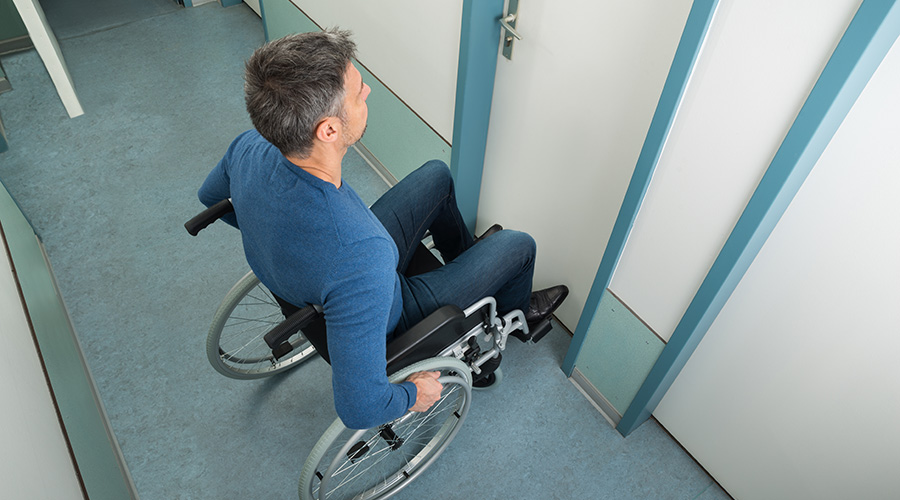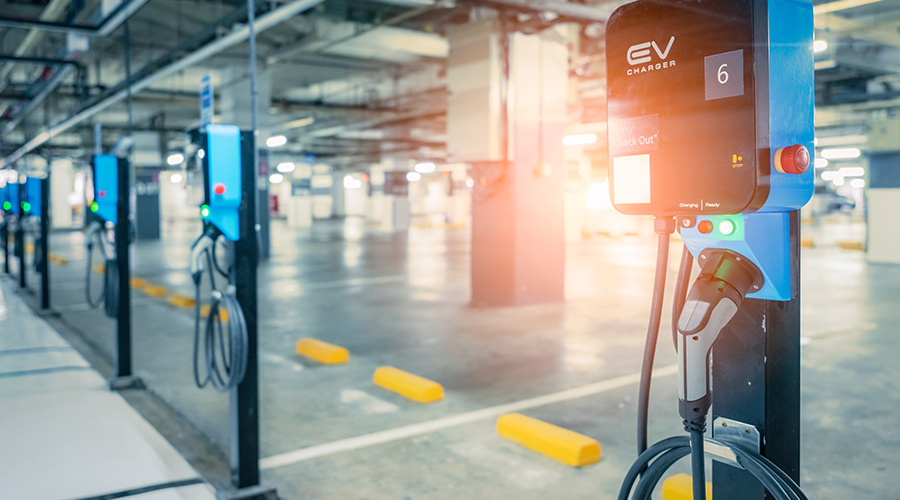Clearing a Path for Access
Tackling these 8 trouble spots in restrooms ensures greater accessibility for visitors and occupants
Restrooms in institutional and commercial buildings remain common areas for accessibility errors because of the many components related to accessibility, including doors, door hardware and dispensers.
A closer look at tested and proven strategies for successfully renovating and remodeling restrooms can help managers address trouble spots in restrooms and can be invaluable in ensuring compliance with Americans with Disabilities (ADA) access guidelines.
Multiple Accessible Features
Managers first need to understand the individual accessibility standards that combine to produce an accessible restroom. Misapplying these standards and requirements or installing products incorrectly not only makes a restroom non-accessible for individuals with disabilities. It also will heighten the probability of lawsuits alleging discrimination under the ADA and state codes.
Remodeling and new construction usually trigger the application of new accessibility standards. If a remodeling or new construction project is not compliant, it is hard to defend the reasons for including newly installed features, such as soap dispensers, that are not compliant. The cost to install a soap dispenser incorrectly is usually the same as the cost to install a compliant dispenser.
Good students do their homework, and the same philosophy applies to contractors and maintenance and operations staff when remodeling restrooms. Understanding accessibility requirements will result in doing the job right the first time.
Specifying compliant products and paying careful attention to installation details will result in compliant restrooms that meet the federal accessibility requirement of the ADA accessibility guidelines (ADAAG) and state codes. Compliance with ADA is a minimum standard. If a state standard requires a greater level of accessibility than the ADAAG requirement, the state standard applies.
To maximize access for facility occupants and visitors when planning a restroom remodeling or renovation, managers can focus on these 8 key areas.
Signage
Even before building occupants and visitors get to the restroom, codes require that directional signage indicate the shortest route. Directional signage provides assistance and information about the location of restrooms for all individuals, but they are especially important for persons with disabilities. In comparison to permanent signage, directional signage does not need Braille and raised lettering. But it must be located at the proper height for viewing.
One common and easy-to-fix compliance item is accessible latch-side signage at the restroom’s entrance. Workers should center latch-side signage at 60 inches on center above the finished floor. All plans should specify that compliant, permanent, latch-side signage contains raised letters and characters, Braille and the international symbol of accessibility (ISA).
While federal requirements specify only latch-side signage, some state codes require additional signage. For example, California requires that doors to restrooms also feature gender symbols — a triangle-shaped sign for men, a circle for women, and a circle on a triangle for unisex restrooms.
Door Considerations
Installers should adjust door pressure to 8-1/2 pounds for exterior pressure and a maximum of 5 pounds for interior restroom doors. The minimum door width is 32 inches.
The maximum allowable change in elevation at a door threshold is a 1/4-inch vertical rise or a beveled 1/2-inch. Threshold ramps made of recycled rubber tires can help provide a compliant threshold transition.
Door swing should not encroach into any clear floor space unless allowed by state code. Both the restroom and the accessible stall must have a 60-inch turning radius. Many restrooms only need a simple reversal of the door swing for compliance.
Door Hardware
A general test for accessible hardware is to determine the required type of grasp. If a piece of door hardware requires tight pinching or grasping or if a user cannot operate the hardware with a closed fist, it probably is not accessible.
Handles that are not accessible for doors include a round, single-knob door handle and thumb-latch or finger-pull doorknobs with less than 1-1/2 inches of clearance. Types of accessible door handles include a lever-type or push-pull handle.
Managers should not specify single-knob, twist-type handles for lavatories because users can not operate them with a closed fist. Instead, automatic openers are preferable.
Door hardware on toilet stalls also must be accessible. A paddle-type latch mechanism that requires no tight pinching or grasping works best. Technicians must install the inside handle immediately below the lock mechanism.
Spaces and Clearances
Technicians should check entry doors to make sure they have the proper latch-side clearance. The push side of the door requires 12 inches of latch-side clearance, while the pull side requires 18 inches.
If latch-side clearance is difficult to achieve or technically infeasible, an automatic door opener might be an acceptable alternative.
Clear floor space is a rectangle 30 inches wide by 48 inches long. The restroom must have a 60-inch turning radius. Managers should be sure to provide clear floor space for a front approach in such areas as urinals and lavatories.
Knee clearance must measure 29 inches under the lavatory and 27 inches at 8 inches under the apron. Lavatory centerlines must be at least 18 inches from the nearest sidewall. Pipes should be wrapped or shielded to prevent contact.
A common misunderstanding is that the pipes do not need to be wrapped if only cold water is provided. But wrapping pipes under lavatories aims not only to prevent contact with hot pipes. It also aims to prevent contact with abrasive or sharp surfaces.
Water Closets
Accessible toilet centerlines must be 18 inches from the nearest sidewall. One solution is to install a knee wall or an offset toilet mount to provide the exact center line measurement.
Installers also should locate flushometers on the wide side. Another way to solve the problem of the flush control location is to add an automatic flush valve.
Toilet seat heights should be 17-19 inches above the finished floor. Managers should avoid using toilet seat spacers to provide elevation to the required height.
Urinals
Urinal rim heights should not be greater than 17 inches from the finished floor, and the flushometer height should not be greater than 44 inches. The rim also must extend 14 inches from the back wall. The urinal must be tapered and elongated and extend a minimum of 14 inches from the back wall.
When specifying or installing urinal shields, make sure they provide a minimum 30-inch width between the shield and sidewall for clear floor space.
Even though a urinal might come in a box featuring the ISA and the product’s literature says it is compliant, managers still must be sure the urinal meets compliance specifications. Compliant products can quickly become non-compliant if technicians install them improperly.
Dispensers
Technicians should not install paper and soap dispensers and hand dryers more than 40 inches above the finished floor for adult standards. It is important to remember that the 40-inch maximum height requirement refers to the operating mechanism or feature, not to the bottom of the dispenser. Some paper-towel dispensers have an operating mechanism or handle that is higher than the bottom of the dispenser.
One way to provide accessibility is to specify a dispenser with automatic controls, such as infrared or motion-sensor-type activation switches. The height at which the dispenser is activated by the automatic control can not be more than 40 inches high.
Installed in the wrong location, toilet-paper dispensers can interfere with the use of grab bars, making the dispensers non-compliant. Technicians can install the paper dispensers recessed so they are flush behind the side grab bar.
Dispensers for sanitary seat cover need clear floor space. Technicians should not install these dispensers over the back of a water closet. A dispenser in this location will not be compliant, due to the lack of the required floor space.
One product on the market combines both the toilet-paper dispenser and a seat-cover dispenser in a flush-mount unit that fits behind the side grab bar and, thus, does not interfere with the bar’s use.
Grab Bars and Mirrors
Side grab bars must be at least 42 inches long. If managers specify and install a 42-inch grab bar, workers must mount it exactly 12 inches from the back wall to meet the extension requirement of 54 inches from the back wall. A 48-inch grab bar enables easier installation to meet accessibility requirements.
Technicians too frequently mount mirrors 40 inches from the frame of the mirror, not 40 inches to its reflective edge. This 1/2-inch height discrepancy will render the mirror non-compliant.
One size does not fit all when it comes to restroom accessibility requirements. Remodeling or renovating restrooms to meet accessible standards and requirements requires research, attention to detail and the selection of products that best meet individual situations.
Some states require greater levels of accessibility, and accessibility requirements might vary according to the age of the primary user. Children’s height requirements and standards might be required.
It makes good sense for managers to do their homework and develop a plan that includes all accessible features of a toilet room. Planning the work and working the plan will provide for an accessible restroom.
Michael Boga is vice president of Disability Access Consultants Inc. (DAC), (800) 743-7067 — a national accessibility consulting firm. DAC assists public entities and businesses with compliance with ADA and related legislation by developing self-evaluations, transition/barrier removal plans, training, consultation, and accessibility-management software.
Related Topics:











